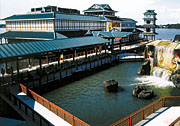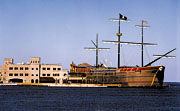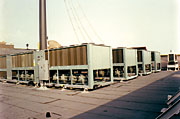

These challenges include dealing with high temperatures and humidities and also taking into account the salt-laden air blowing in off the ocean or gulf, which has a corrosive effect on equipment. In addition, all the electrical and plumbing systems must be able to be quickly disconnected in case the casino must be moved for an emergency, such as a hurricane. Other challenges, such as designing to two different codes – the Coast Guard code, as well as the local building code – and building on a fast track are also thrown into the mix.
Still, most engineers working on these projects just love them, because they’re different. Yes, they’re challenging, and yes, there are numerous problems that can spring up. But that’s what makes a mechanical engineer’s life so interesting.
Shuffling Salt and Security Issues
One engineer who loves the challenge of designing mechanical systems for floating casinos is Tom Richardson, P.E., The Richardson Engineering Group Inc. (St. Louis). He designed the electrical, mechanical, plumbing, and fire protection systems for both the 40,000-sq-ft Lady Luck Casino, as well as the 60,000-sq-ft Treasure Bay Casino, both of which are floating casinos in Biloxi, MS.One of the first issues that came up when designing the systems for these casinos was the need to have everything be easily disconnected and moved. “These casinos float freely, but it’s required by law that they be able to be moved in case of a hurricane,” says Richardson. “That’s one of the big problems. All the plumbing, sanitary systems, gas service, and all electrical services must be able to be quick-disconnected and ready to move in an hour’s notice.”
To keep all systems operational – and to ensure the security of any money on board — total coverage generators and uninterrupted power systems keep the casinos operating regardless of the interruption in normal power supplies. “In an emergency, someone could pull a fast one. All the monitoring has to stay in place while in an emergency situation,” says Richardson.
Another issue that was a concern almost immediately was the amount of salt in the air, which would blow in off the Gulf of Mexico. Normal equipment would corrode in no time at all, so equipment had to be ordered with special coatings on the coils in order to be more resistant to the salt in the air.
With these issues in mind, Richardson went about designing the system. Both casinos have on-board central chiller plants. The Lady Luck requires 600 tons of cooling, which is provided by three chillers, while the Treasure Bay requires 1,200 tons for the casino alone, provided by four chillers. (The latter casino also has land-based facilities that include offices, restaurants, and gift shops, and these required 750 additional tons of cooling.) Terminal reheat is used on those rare occasions when the temperature drops a little too low to be comfortable.
“We oversized the equipment by about 25%, because the casinos run 24 hours a day. They’re never down. The owners don’t want to have the air conditioning go out and shut them down and have people leave because it’s too hot in the casino. Since we oversize the equipment, they can lose a compressor on a chiller or perform regular maintenance, and the system will still work just fine. Redundancy is a very big factor in casino design,” says Richardson.

Ventilation in Spades
Another consideration that has to be taken into account when designing a casino (not just the floating variety) is the amount of cigarette smoke in the air. Smoking is permitted in most casinos, yet owners are very sensitive to the fact that other patrons may not want to smell environmental tobacco smoke (ETS). In addition, there are often times when significant numbers of people may be in the casino at one time. For these reasons, vast amounts of ventilation are required.In the Lady Luck and Treasure Bay Casinos, Richardson designed ventilation rates to be around 2 cfm/sq ft – sometimes even higher. “We have very heavy air loads in both casinos. That’s why we put in variable-air volume systems. We have nine air handlers on Treasure Bay and six air handlers on Lady Luck,” says Richardson.
Naturally, ductwork that has to supply 2 cfm/sq ft is going to be quite large — much larger than what would be seen in an ordinary building. But, fortunately, most architects have come to the conclusion that casinos require a lot of space above the ceiling. Not only to handle the oversized ductwork, but also to place security cameras, as well as electrical, plumbing, and sprinkler services.
“There are also electrical wireways and cable trays everywhere, because virtually every slot machine is a computer now, and all of it requires wiring,” says Richardson. “We had about 5 ft of room above both ceilings in these casinos.”
To handle the cigarette smoke in the casinos, air cleaning equipment and demand-controlled ventilation, which monitors CO2 levels and varies the outside air accordingly, were used. The air cleaning equipment consisted of a bipolar ionization system, which is a filtration system that will take out a lot of the impurities in the air and allows lower outside quantities than is required by code normally.
“The owners wanted the casino patrons to be comfortable, and every time I’ve been there, it’s been very comfortable. And I’ve never been able to see any smoke, and I must say there are a lot of smokers in a casino. The smoke disappears very quickly, which is the result of high turnover of the air. You have to turn that air over in order to get rid of the smoke. When smokers are smoking, you want the air to go straight up and out fast — you don’t want it to hang around and drift over and upset the player next to you,” says Richardson.
The indoor comfort conditions, including space temperature, interior humidity, and air quality are monitored, measured, and controlled by automated systems, which alert the building maintenance department with a tabulated report if preset limits are exceeded.
Tough Odds on Total Loads
With all that ventilation comes hot and humid air flowing into the casino. Taking that into consideration was very important because Richardson had to be very careful in selecting the right equipment. “We had to run accurate load calculations and do a good coil selection because there’s a heavy latent load there. Humidity is taken care of by having enough rows of coil in the air handlers to be able to wring the water out of the air. As long as you have enough rows in your coil, you can take that moisture right out.”Unfortunately, coming up with accurate load calculations was sometimes difficult, because the amount and placement of gambling equipment, lighting, and signage changed often during the course of the projects. And, even the locations of restaurants, bars, and other amenities were changed around at the last minute.
The amount of gambling equipment placed in a casino is significant because every slot machine is a computer, and every one of them puts off a little bit of heat. Given that these slot machines are generally installed wall-to-wall, this can add up to a considerable load. “It’s very tough to get a good handle on the loads that you’re going to be doing. You have to have a good crystal ball,” notes Richardson.
Besides the fact that loads and room locations may change often, these projects are often on a fast track. “In fact, fast track doesn’t even describe it. It’s frantic track. They build around the clock, and most of the time, engineers are just trying to keep up with what’s going on in the field,” says Richardson. “Owners are making changes all the time, and a big part of the project is still being decided on while we’re building the casino. That’s the biggest challenge.”

More Codes Than Cards
And as if the concerns for floating casinos already outlined weren’t enough, there are still more: When building onto a barge or any kind of floating device, anything below the first deck is built to very strict Coast Guard standards. Anything above the first deck is built to the regular building code. And it’s necessary to follow both codes.While there is not much hvac located below the first deck of either floating casino (Treasure Bay has a penthouse mechanical room and Lady Luck has its equipment located on several mezzanines), the plumbing code is very stringent. The code requires holding tanks to be on board, and then those tanks can be pumped out overboard.
There are also separation chambers in the barge that are there to keep the boat from sinking, and all those have to be watertight and have very strict controls. “Every time you take a pipe through one of these things, you have a lot of codes and regulations on how you do that and how you seal that up again. It’s not like doing your normal plumbing job where you just run the pipe through. Then we had considerations for the electrical aspects below decks. It was altogether different for the Coast Guard. It is complicated,” notes Richardson.
Once you come ashore, there are Federal Emergency Management Agency (FEMA) regulations for flood control. That’s because water is allowed to only come up so high on the side of the casino, and the building has to be built to withstand high surf conditions or flooding.
On top of that, it’s necessary to make sure the casino is stable and doesn’t capsize; a real concern what with all the mechanical equipment, gambling machines, and people aboard. For this reason, a naval architect must be involved with the project. That architect’s job is to analyze the stability of the boat, so he weighs and considers every pipe and every piece of equipment that goes onto that barge and where it’s going to be.
But all these concerns don’t deter Richardson. “This is what mechanical and electrical engineers live for. These projects were a challenge, they were fun to do, and I enjoyed them. I’d do it again in a heartbeat.”

Horseshoe Casino Posed More Challenges
Imagine the challenges involved in designing a unified comfort system for a 25-floor deluxe hotel with 606 rooms connected to an enormous floating casino and a temporary theater with seating for 1,350. Add to that a growing attached luxury retail area and four restaurants plus an employee cafeteria, as well as the need to allow for expansion of at least another 300 hotel rooms. Then consider that the facility is located in Bossier City, LA, where hot temperatures and high humidity are the norm in the summer.This was the daunting challenge facing the owners of the Horseshoe Casino and Tower. Riverboat gambling is the centerpiece of this facility, but it also has extensive convention facilities and a growing retail center. Both of these are on shore and connected to the floating casino.
Because of the owners’ concerns that patrons be comfortable, the hotel cooling is done with a chilled water system with individual fancoil units in guest rooms and variable air volume (vav) equipment in public areas, including hallways, restaurants, and retail areas. These are supplemented with blower coil air handlers.
The actual 29,840-sq-ft casino, the “King of the Red,” is aboard a boat on the Red River. Cooling for the casino portion is provided by three Trane screw chillers. High levels of outdoor makeup air are mixed into the air stream in the casino area through air handlers and a vav distribution system. Even though smoking is allowed in the casino, high ventilation levels make it almost unnoticeable. And because of these high ventilation levels, deep coils and low chilled water temperatures are essential for adequate dehumidification.
In the hotel, high ventilation levels mean aggressive dehumidification is a requirement. The first portion of the shore facility was built in 1994 and is served by two 350-ton Trane centrifugal chillers. In 1998, the hotel was expanded and the temporary theater was added. With these additions came two more 850-ton chillers. For both pairs of units, the typical summer condenser water temperature is 97˚F and 90˚F returning.
The long-term goal is to combine the two pairs of chillers into a single chilled-water loop.

